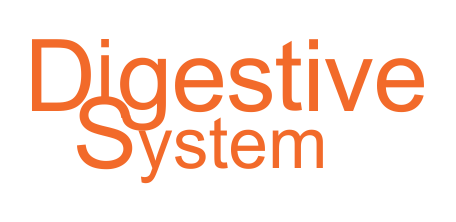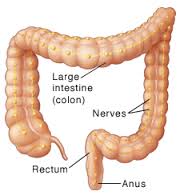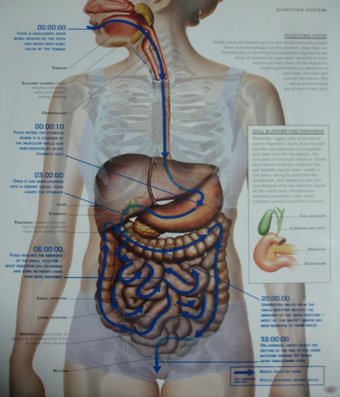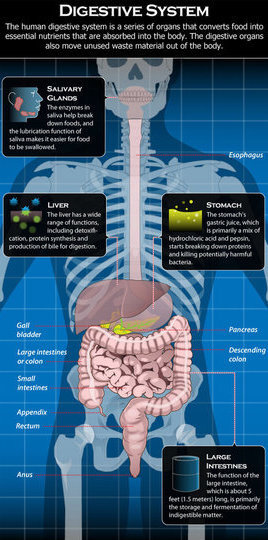
Do you think that everything we eat is utilised by the body? Do we get the expected nourishment from everything that we consume? No. There are some foods like bread, meat and vegetables which do not provide the necessary nourishment as they cannot be absorbed into the blood. They need to be broken down so that they can be utilized by the body to nourish the cells and provide energy. This function is performed by the Digestive System. The Digestive System is responsible for digesting the food and providing the vital and necessary nutrition to the body.
Digestive System comprises of the:
-
Mouth: Digestion begins in the mouth. The salivary glands in the mouth get triggered with the smell of the food which secrete saliva and causes the mouth to water. These juices break down the food and help digestion.
-
Pharynx and the Oesophagus: Pharynx or throat receives the food from the mouth and takes it to the oesophagus, which then carries the food to the stomach. The Pharynx is a link between the tongue and the soft palate and the oesophagus. The oesophagus is a muscular tube that passes the food to the stomach with the help of a series of contractions called peristalsis.
-
Stomach and Small Intestine: The stomach has strong muscular walls and serves as a mixer and grinder of food. It is in the stomach that the powerful acids and enzymes are secreted. These enzymes help in the breaking down of the food and allow it to move to the small intestine. The small intestine helps to break down the food with the help of the enzymes that are released by the pancreas. The small intestine is made up of three segments, namely, the duodenum, jejunum and the ileum. The duodenum is responsible for the breakdown process, whereas the other two, jejunum and ileum are responsible for absorption of nutrients in the bloodstream.

-
Colon, Rectum and Anus: The Colon or the large intestine is a tube that connects the small intestine to the rectum. The large intestine is very important as it processes the waste and enables the defecation to be easy and convenient which is done through the anus.

The enzymes are:
-
Protease: It helps to break down the proteins
-
Lipase: It breaks down the fats and oils
-
Amylase: It helps to break down starch and sugar
-
Lactase: It breaks down the dairy products
-
Cellulase: It helps in breaking down the vegetables and cellulose material
The Digestive System is important for the body because it helps the organs to convert the food into essential nutrients that are absorbed into the body and moves the unused waste material out of the body. These series of organs make up the digestive tract. The digestive tract consists of the mouth, oesophagus, stomach, small intestine, large intestine and the anus. The lining inside these hollow organs are called mucosa which is found in the mouth, stomach and the small intestine. The mucosa contains tiny glands that produce juices to digest the food. The two main organs of the Digestive System are the liver and the pancreas. They help in producing the digestive juices that reaches the intestines through the ducts. Until the juices are needed by the intestine, the gallbladder stores them.

The general process of digestion involves the mixing of the food in the digestive tract and the molecules break down. It begins in the mouth and is completed in the small intestine. Food is digested by the following process:
-
Movement of food through the system: The process through which the food moves from one organ to the next through the muscle action is called peristalsis. The movement of organ propels the food and liquid through the system to mix the contents within each organ. The muscles perform their first movement when the food is swallowed. The food is then pushed into the oesophagus and approaches the closed sphincter and then allows the food to pass through the stomach. Here the stomach performs three important tasks; namely, to store the swallowed food and liquid, to mix the food, liquid and digestive juices produced by the stomach and to empty its contents slowly into the small intestine. The digested nutrients are absorbed by the intestinal walls and transported throughout the body whereas the undigested parts of the food are shed from the mucosa. The fiber remains in the colon until the faeces are expelled from the bowel.
-
Production of digestive juices: The salivary glands are the first digestive glands that act in the mouth. The saliva contains an enzyme that breaks down the starch in the food into smaller molecules.
-
Absorption of the nutrients: The digested molecules are absorbed by the small intestine. The mucosa contains tiny finger like projections called the villi. The materials are absorbed by the specialized cells to cross the mucosa into the blood and are carried to other parts of the body.

The hormones and nerves control the digestive process of the body.
-
Hormone Regulators: The major hormones are produced in the small intestine and the stomach and are released into the blood of the digestive tract, travel to the heart and come back to the Digestive System where it stimulates the digestive juices and cause organ movement. The hormones that regulate digestion are:
-
Gastrin: The acids produced in the stomach for dissolving and digesting some foods is caused because of Gastrin, and it is responsible for the normal cell growth in the lining of the stomach, small intestine and colon
-
Secretin: This is a digestive juice which is rich in bicarbonate and is secreted by the upper duodenal mucosa in answer to acidification in the deodenum. Secretin is a polypeptide made up of 27 amino acids. An enzyme, pepsin that helps to digest protein is stimulated by the Secretin.
-
Cholecystokinin (CCK): It causes the gallbladder to be emptied and enables the pancreas to secrete enzymes.
In most cases the following symptoms reflect a digestive disorder.
-
Heart burn
-
Lump in the throat
-
Fever
-
Sore throat
-
Constipation
-
Nausea and vomiting
-
Pain or burning ache in the upper abdomen.
-
Swelling around the anal area.
Foods that are rich in fats take a longer time to digest. This may include ghee, butter, milk, cheese, bread, dark chocolate and foods that are fried in excess oil, whereas foods like meat, fruits, dark green vegetables, soups, etc. digest within a short time.
Colon Cancer, irritable bowel syndrome, lactose intolerance, diverticulitis, peptic ulcer and celiac disease are some of the diseases.


